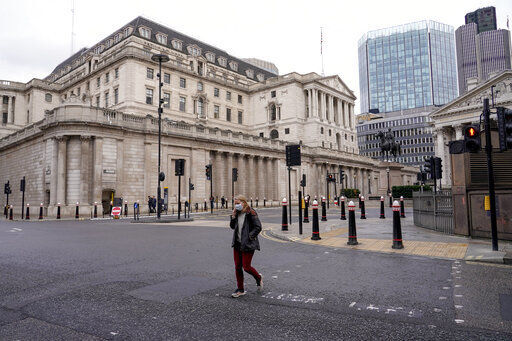LONDON — The Bank of England raised interest rates for the second time in three months today, putting the United Kingdom far ahead of the rest of Europe and the U.S. in moving to tame surging inflation that is squeezing consumers and businesses.
The bank’s monetary policy committee voted 5-4 to boost its key rate to 0.5% from 0.25%, with the dissenting members arguing for a bigger increase. It also voted unanimously to begin reducing holdings of U.K. government bonds and corporate debt, which the bank has built up since the global financial crisis more than a decade ago to bolster the economy.
U.K. consumer prices rose 5.4% in the year through December, the highest inflation rate in almost 30 years. The squeeze is only going to get worse with household energy prices expected to jump a record 54% in April and income taxes set to rise by 1.5% the same month.
“Amid the global monetary policy regime shift from easing to tightening, the Bank of England is storming ahead, pressing forward with decisive action as a time when other central banks are falling behind the curve on inflation,” said Victoria Scholar, head of investment at Interactive Investor.
The decision comes a week after the U.S. Federal Reserve said it would end its own asset purchases in March and was likely to raise interest rates for the first time in more than three years. Monetary policymakers around the world are trying to contain inflation fueled by rising energy prices and supply shortages as the global economy recovers from the COVID-19 pandemic.
By contrast, the European Central Bank doesn’t plan to raise rates until 2023 despite record inflation in the 19 countries that use the euro, blaming it on temporary factors. At a meeting Thursday, it stuck to its plan of carefully dialing back its key economic stimulus efforts over the next year. The bank is facing questions about when it will hike rates to ease high prices.
Meanwhile, investors expect the Bank of England to raise its key rate three times this year, pushing it to 1% by August.
The bank adjusts interest rates as it tries to keep the inflation rate below 2% while also promoting economic growth.
Higher rates increase how much borrowers pay on everything from home mortgages to credit card purchases, reducing spending and slowing price increases. Lower rates tend to encourage spending and increase economic growth.
The Bank of England began buying U.K. government bonds and corporate bonds held by financial institutions in 2009 to pump money into the economy during the global financial crisis. Policymakers were forced to turn to asset purchases after they had slashed interest rates to 0.5%, limiting their ability to use interest rates to stimulate economic growth.
With rates remaining near record lows, the bank continued to buy bonds during the shocks caused by Britain’s departure from the European Union and the pandemic. It is now the single biggest holder of U.K. government debt, owning 875 billion pounds ($1.19 trillion) of government bonds, known as gilts.
Last August, the bank said it would begin reducing its bond holdings once the key interest rate reached 0.5%, “if appropriate given the economic circumstances.”
The bank said it would reduce the holdings gradually, initially by not reinvesting the money it gets from maturing bonds. Sales of the assets wouldn’t begin until rates reached 1%, the bank said.
That strategy contrasts with the Federal Reserve, which is likely to take a more staggered approach, ING economists Antoine Bouvet and James Smith said in a note to investors.
“Despite this bolder start, the early phases of the BoE’s balance sheet reduction … look manageable,” they wrote. “Initially, it will simply amount to a large, predictable, and recurrent buyer not turning up to buy gilts.”


